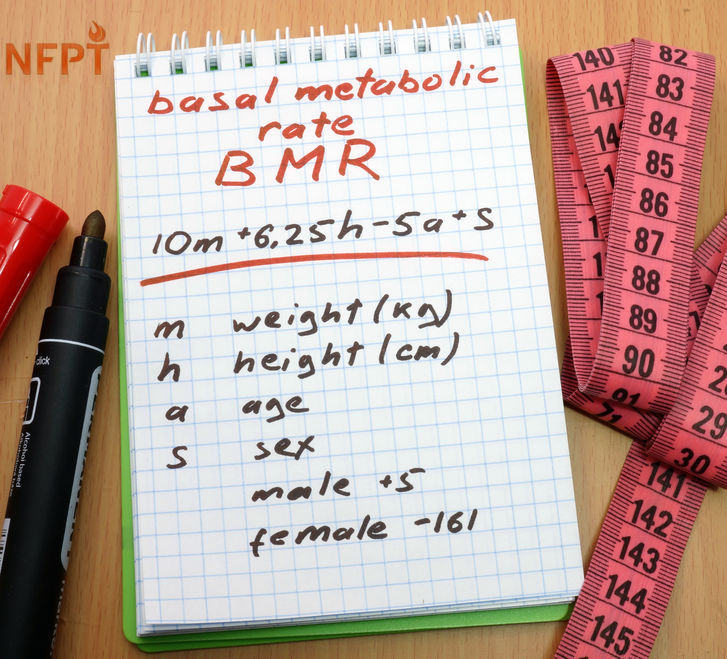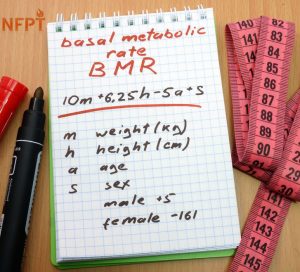
Restricting calories below metabolic needs might initially sound like a surefire path to fat loss for our personal training clients who want to be leaner. However, this process often backfires when the body’s protective mechanism of entering “starvation mode” kicks in. Fat reserves get stored, to be utilized as energy until the body is once again appropriately nourished. Here’s why consuming below Basal Metabolic Rate (BMR) is a bad idea for even the most determined weight loss clients.
The Body as a Machine
Think about the human body as a car. By putting fuel in a car, the engine runs efficiently, enabling the vehicle to move. In a similar fashion, the body utilizes calories from food, or energy, in order to execute and maintain all of life’s functions. Insufficient caloric intake slows the body’s metabolism considerably.
In desperate need of a fuel source, without enough energy, the body begins to tear down muscle tissue, generating a drop in lean muscle mass, despite efforts used during exercise.
In the case of grossly underfed bodies, or if too long between a period exists between meals — over three or four hours — the body slows its metabolic rate in an attempt to conserve energy. This is an evolutionary process, much like a bear entering hibernation. This explains how severely restricting calories for purposes of weight loss almost always fails.

In a 2005 study, Friedlander et al measured the results of restricting diet to 40% of caloric needs in nine young, healthy men for 3 weeks. Protein intake was maintained at proper levels of 1.2 grams/kg; still at the 3-week assessment, the men lost an average of 3.8 kg, half of which was lean muscle mass.
Furthermore, at the end of the 21 days, the collective BMR dropped over 200 calories! Although aerobic capacity was not significantly impacted, muscle endurance did decline by 20%.
Surprisingly, our BMR constitutes the majority of a body’s calorie needs — about 60 % of total energy expenditure, according to research from the University of Colorado at Denver. Calories utilized to metabolize food and to fuel activity comprise the remaining 40%.
Lean muscle tissue remains the body’s biggest BMR calorie burner. Therefore, determining a client’s BMR can help you estimate his/her caloric needs for losing weight. Keep in mind that BMR slows as weight goes down, requiring even fewer calories for maintenance.
How Restriction Impacts BMR
Severely restricting calories forces hormonal adaptations to kick in during this “protective mechanism” mode, most notably affecting circulating levels of leptin, thyroid, and testosterone. These changes initiate the cascade leading to a depressed metabolic level. If a client begins a training/dieting program with you, understanding this process can help guide both his workouts and his meal planning.
Adding in Exercise
If a client indicates acceptance of the gradual loss of his excess poundage, (as opposed to a sudden, precipitous drop) you can help him/her set smart and attainable goals. When one reduces daily intake by 300-600 calories, the aforementioned hormonal changes do not pose a threat and the individual progressively loses weight.
At this point the client may also increase activity and exercise; here is where metabolism hangs in a delicate balance.
If the client adopts a less-than-optimal meal plan and reduces caloric levels too significantly, the hormonal scale is thrown off. He/she may notice that the amount of energy available for workouts plummet. While it may seem counterintuitive, the client ends up burning fewer calories for each hour of exercise.
Muscle Mass to the Rescue?
While muscle remains the most metabolically active tissue in the body (as compared to fat and bone), the increase is measurable but small. However, the addition of lean muscle mass is always advantageous.
The workouts that facilitate building muscle are not for the faint-of-heart, and require the consumption of additional calories to fuel and recover. This presents a conundrum of sorts for a client whose goal is weight loss, since shedding fat requires one to burn more than he consumes.
The difficult paradox: by engaging in a calorie deficit to lose fat, the muscles end up lacking the fuel to grow. Does generating sufficient energy levels for anabolic muscle growth fly in the face of caloric reduction for weight loss?
Since meal planning for a client is outside the scope of practice for a personal trainer, suggest that s/he reach out to an exercise-focused nutritionist. Otherwise, reviewing food logs, caloric intake, and macronutrient balance is certainly within your purview. In general terms, we know that protein and amino acids are the building blocks of lean muscle tissue. Armed with such knowledge, clients often hesitate to include carbohydrates and fats into their weight-loss regimen.
You can explain in easy-to-understand language how glucose, or glycogen, is the body’s preferred fuel source, obtained in a healthy manner by taking in sufficient amounts of appropriate carbohydrates, both prior to and/or upon completion of a workout. Individuals who are in the process of severely restricting their calories often eliminate entire food groups from their menus. We can provide an invaluable service by outlining how the presence of a variety of healthy fuel sources allows for “muscle-sparing”.
Matching Nutrition to Goals
The uniqueness that defines every single individual extends from the gym and to the kitchen as well. Depending upon gender, build, genetics, and general physical output, clients are going to utilize energy and create deficits in differing ways.
Regardless of this, the greater the intensity of one’s workout, the more time the body takes to recover. During this recovery period, the body continues to burn additional calories. Although there exists great variation from person to person, post-exercise metabolism often remains elevated for up to 48 hours, according to expert Len Kravitz.
It may be disheartening to recognize that a typical strength training workout on average only utilizes 180 to 266 per hour. This quantity proves difficult to calculate because training large muscle groups inevitably requires more energy than working smaller muscles. However, such a session also gradually increases muscle mass, helping the body to more effectively burn calories even at rest.
The Aerobic Factor
For all of its benefits, strength training will not burn as many calories as cardiovascular exercises, minute for minute. However, we must teach our clients to take into consideration the whole fitness outlook. Many individuals remain stuck on the notion that constantly increasing their aerobic training is the path to losing fat.
When losing weight, some muscle mass will get utilized along with body fat. During the period of a calorie deficit, it is vital to continue resistance training regularly; if it is neglected in favor of running or cycling, potentially up to 30% of the weight lost comes from that hard-earned muscle tissue. As we will cover further in this article, adding “size” to one’s body through serious bodybuilding and proper nutrition will also invariably add at least some adipose tissue in the process since a caloric surplus is required.
The Challenging Calculation
Once you and your client have determined roughly how many calories they burn daily, you can begin to address a nutrition plan. A dedicated strength-training male client can maximally build a half-pound of muscle, and a woman can maximally add a quarter of a pound in a week’s time, at best.
Experimenting over time with the addition of calories is challenging, knowing that a surplus will add some adipose tissue along with muscle. Some experts suggest beginning with an additional 250-500 calories each day, and adjusting down if too much adipose is gained.
A hard-gaining client would aim for a higher number, whereas one who finds shedding weight to be a slower process would start adding calories cautiously. Discovering the client’s “sweet spot” between an insufficient calorie increase and too great of a gain, becomes simply a matter of trial and error.
It has been widely accepted that in an effort to gain muscle while acknowledging that fat will come along for the ride requires around 3,500 additional calories in a 7-day period, though this is an estimation. Extra caloric energy beyond what is needed to fuel workouts, recovery and addition of muscle mass will indeed get stored as fat.
The job of a highly trained and successful fitness professional includes an awareness of a client’s goals and motivation, as well as the path of your joint journey to success. Patience, support, and attention to detail are key players here. Reassure your client that adjustments can always be made and what may appear to be undesirable weight gain is not a “failure” and can certainly be reversed with some tweaking.
Be observant during training sessions: does the client seem to lack energy? Is s/he pushing significant weight loads with no visible addition of muscle mass or strength gains? These clues point to an insufficient amount of energy entering the body and a disruption to the BMR and metabolic processes. Armed with the knowledge gained here, you can feel confident in addressing this topic in a safe and appropriate manner.
References:
www.verywellfit.com/how-many-calories-does-muscle-really-burn-1231074
www.livestrong.com/article/159193-calorie-intake-to-gain-muscle/
muscleevo.net/how-many-calories-to-build-muscle/
www.cnn.com/2009/HEALTH/expert.q.a/06/05/building.muscle.nutrition.jampolis/index.html
www.sport-passion.fr/en/health/strength-training.php
www.sparkpeople.com/blog/blog.asp?post=you_asked_how_many_calories_does_strength_training_burn
www.livestrong.com/article/429708-how-long-does-your-body-burn-calories-for-after-a-workout/
www.healthline.com/nutrition/calorie-restriction-risks
www.livestrong.com/article/485498-does-exercise-raise-your-metabolic-rate-for-several-hours-after-the-workout/
www.fionapococktraining.com/articles/under-eating-over-training-part1
www.verywellfit.com/can-i-lose-fat-and-gain-muscle-at-the-same-time-1231586
www.livestrong.com/article/266994-how-to-lose-weight-with-bmr/
www.eatingwell.com/article/290811/can-losing-weight-slow-your-metabolism/
runnersconnect.net/might-not-lose-weight-even-gain-weight-eat-less-run/
https://www.ncbi.nlm.nih.gov/pubmed/15870104







